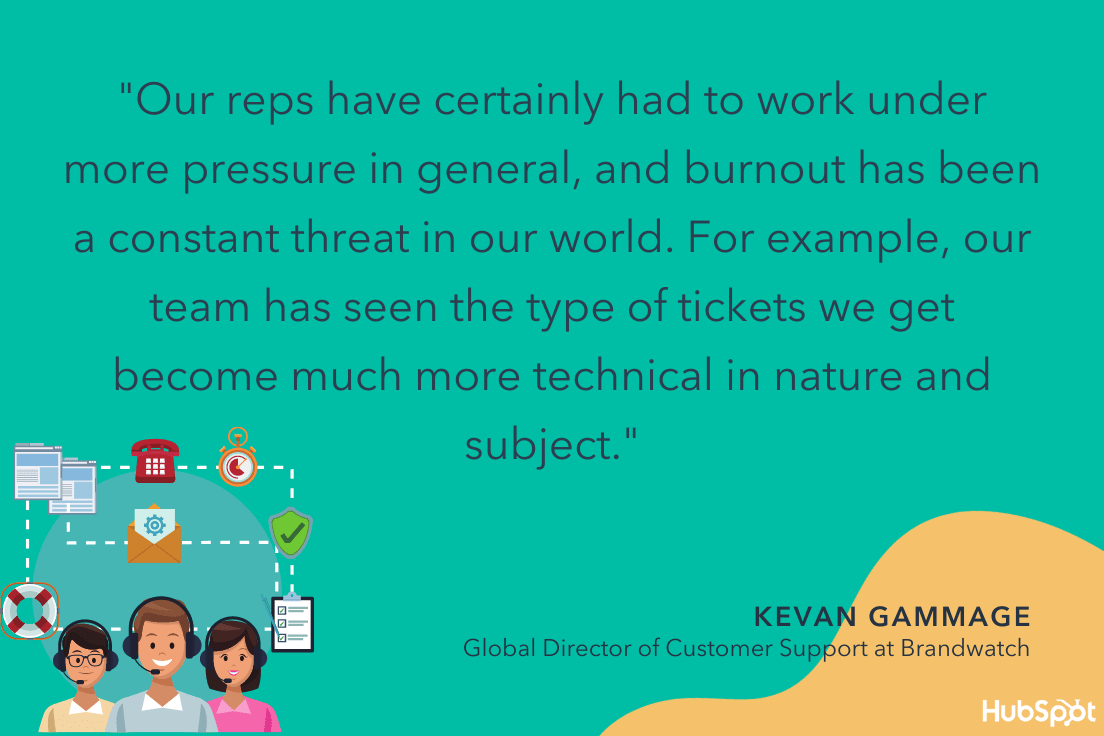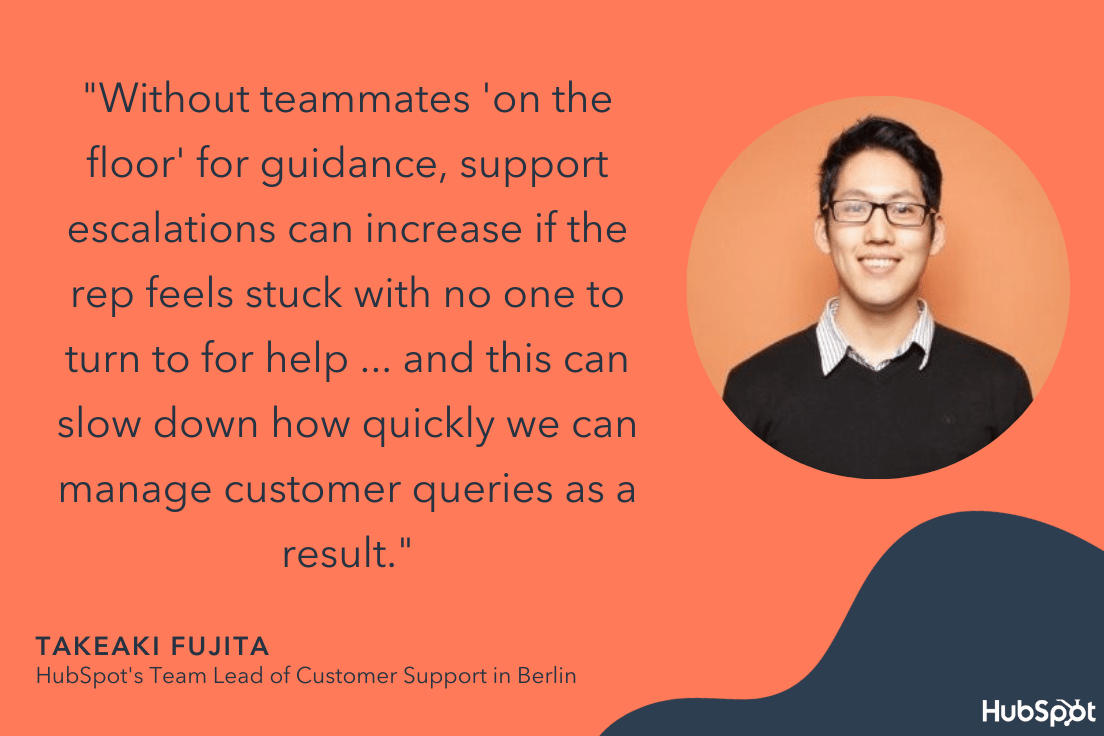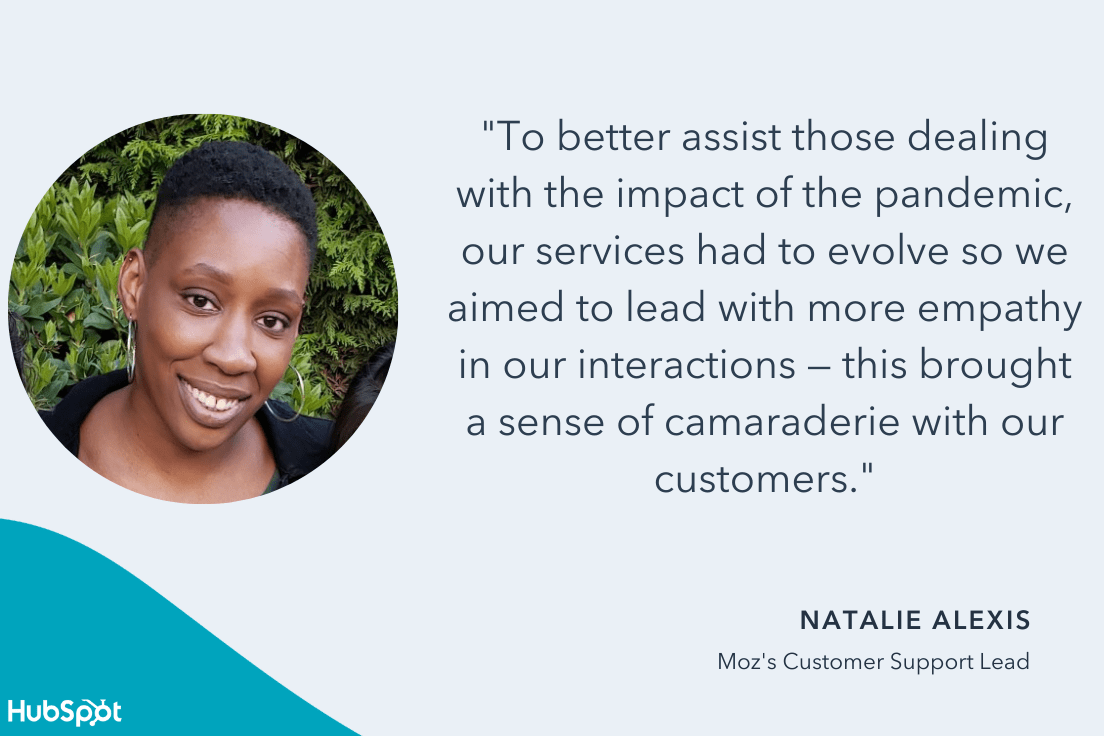We all know the importance of customer service for retaining customers and scaling a business — and it’s only increasing in value over time.
Consider, for instance, what happened when I called CorePower Yoga’s customer service team last week to complain about an incorrect charge to my account. What could’ve been a stressful and frustrating experience turned into me actually upgrading my membership.
That’s the power of good customer service — it’s where your customers’ loyalty starts, or ends.
Unfortunately, the past two years have been anything but easy on customer service teams. While customers’ expectations for customer service hit an all-time high, customer service reps simultaneously saw more difficult calls and increased escalations in 2020.
HubSpot’s Industry Data, for instance, shows a consistent rise in support tickets since the beginning of the pandemic — from 6% in March of 2020 to over 90% as of August 2021:

However, as customers’ challenges and requests increased exponentially as a result of the pandemic, most service teams were still struggling to adjust to a fully remote setup. (Imagine the stress of a conversation with an unhappy customer from your kitchen table, where you might lack a strong phone connection or easy access to peers for help. Yikes.)
All of which is to say: COVID-19 had a strong impact on customer service, and in 2022 and beyond we’ll continue to see the ramifications of the pandemic on what customers expect from customer service, and how service reps will need to adjust to handle those new expectations.
Here, I spoke with six experts in the customer service industry to gather insights into the future of customer service. Let’s dive in.
How COVID-19 Impacted Customer Service
1. Service reps needed to adjust business offerings to meet new customer demands.
Microsoft’s Worldwide Support Leader Kirsten Gudmundson told me it’s vital service teams learn to adjust to their customers’ unique needs, which might be different than they were pre-pandemic.
“Listen, learn, evolve — quickly,” Gudmundson told me. “During the pandemic, our customers’ needs were evolving at warp speed as many had to quickly go through a digital transformation to stay relevant.”
Gudmundson adds, “It was imperative that we actively listened and adjusted our offerings to meet new customer demands and identified innovative ways to engage with customers.”
The pandemic required all businesses to re-route existing strategies and refocus their efforts. If you work for a B2B customer service team, then, it’s important to keep in-mind that part of your job is exhibiting patience and empathy when working with your customers.

Additionally, the ‘rule book’ you followed pre-pandemic might not work anymore. Part of the challenge of the service industry today is having the flexibility to alter your approach — and your business offerings — as you identify better ways to serve your customers.
As Gudmundson points out, “By making it easy for customers to get support and proactively providing services, we gave customers peace of mind, which allowed them to focus on this critical pivot point for their business.”
2. Burnout across service organizations increased.
According to a 2020 Gallup report, 76% of employees experience burnout on the job at least sometimes, and 28% say they are burned out ‘very often’ or ‘always’ at work.
Burnout has increased dramatically as a result of the pandemic. Work-life balance has blurred significantly. Additionally, some employees feel pressure to remain online to prove their working to their managers — and still others need to adjust to working from home while also taking care of their children or dealing with other household responsibilities.
Unfortunately, service employees are particularly at-risk of burnout. As researcher Kristina Hultgren writes, “call centre jobs are notorious worldwide for their high levels of turnover, absenteeism, employee burnout and emotional exhaustion.”
Kevan Gammage, Global Director of Customer Support at Brandwatch, told me he’s seen burnout increase for his own team after joining Brandwatch at the beginning of 2021.
“For us, the pandemic has been a bit of a ride,” Gammage says. “It seems like customers have been reasonable in understanding that our team is also impacted by COVID, but that only carries so far.”
“Our reps have certainly had to work under more pressure in general, and burnout has been a constant threat in our world. For example, our team has seen the type of tickets we get become much more technical in nature and subject.”
To deal with burnout, Gammage told me he’s needed to become more intentional about how he creates a connected environment for the team, even if that environment is fully remote.
Additionally, he told me, “We do our best to avoid burnout by encouraging our folks to take advantage of unlimited vacation. We also like to give the team specific self-development time to work on things that are more personal, like self-development or mentoring from teams they aspire to work in. So far, so good — but we have to continue to be creative for the team.”

3. Customers became more familiar with communication tools like Zoom and Google Meets.
Fatima Sbeih, Beautiful.ai’s Director of Customer Success, told me her team’s customer support requests nearly doubled at the beginning of the pandemic.
Sbeih says, “As a remote collaboration tool, new users adopted Beautiful.ai early in the pandemic as they transitioned to working from home. As a result, [our] customer support requests nearly doubled, leading to longer response times and adjusting priority levels for support tickets. This — coupled with the inherent collaboration challenges of remote work — resulted in a backlog of tasks.”
Sbeih told me, “Clear and concise internal communication became an even higher priority than before, as did the mental health of my team to ensure everyone felt supported.”
To ensure strong internal communication on your own support team, consider investing in powerful customer service tools, such as HubSpot for help desk software or JIRA for bug reporting.
Sbeih told me one of the most notable improvements to customer service that she’s seen has been a more geographically diverse talent pool that aligns with customers’ timezones. She notes that this has decreased wait times for first-time responses, and allowed for calls to be scheduled within business hours for each team.
As your team became more comfortable with remote software in 2020, so did your customers. This is a major benefit for remote support teams, as customers are more efficient at submitting and responding to requests on communication platforms outside of traditional phone calls.
As Sbeih puts it, “customers became more comfortable with communication tools like Zoom and Google Meets, enabling easier assistance.”
4. Remote support coaching became a requirement.
As people adjusted to this ‘new normal’, tensions were high. Along with the daily challenges they faced at their companies, customers also dealt with the extreme pressures of a global pandemic.
All of which is to say: 2020 wasn’t an easy year for anyone in a customer-facing role.
As HubSpot’s Team Lead of Customer Support in Berlin Takeaki Fujita puts it, “customer-facing teams were on the frontline for managing customer frustrations — which can be stressful for customer support teams to manage.”
Additionally, Fujita points out that the loneliness and isolation of a remote lifestyle can also impact the productivity of support reps. “Without teammates ‘on the floor’ for guidance, support escalations can increase if the rep feels stuck with no one to turn to for help … and this can slow down how quickly we can manage customer queries as a result.”

To mitigate the loneliness and frustration for your team, you might consider offering remote coaching for your support reps. As Fujita told me, championing collaboration within and across teams, encouraging transparency, and keeping communication channels open is vital for enabling reps to share knowledge and learn from one another.
Fujita adds, “Empowering reps with recurring virtual support and proactive coaching can lay the foundations for effective, personalized support interactions, which can only help our customers to grow better.”
5. Service reps needed to develop or nurture a stronger sense of empathy in their customer interactions.
When a customer is calling a customer service representative, they’re usually facing a challenging, frustrating, or disruptive situation. In 2020, it became increasingly important for service reps to lead with empathy in their conversations with customers.
As Moz’s Customer Support Lead Natalie Alexis puts it, “Early on, we saw an increase in customers seeking help for their businesses to survive. To better assist those dealing with the impact of the pandemic, our services had to evolve so we aimed to lead with more empathy in our interactions — this brought a sense of camaraderie with our customers.”
“But as the pandemic has persisted,” Alexis adds, “we’ve seen the impacts of the sustained stress on our customers. We’ve continued to focus on providing empathic service while acknowledging the increasingly stressful times we live in.”

Empathy is the ability to put yourself in someone else’s shoes. This is particularly critical for customer support reps. To help your team develop empathy, consider how you might show them what your customers experience on a daily basis.
If you sell software, for instance, you’ll want to ensure your customer support reps have all been trained in how to use your software — the challenges they experience as they learn how to use your tools will help them understand and relate to your customers’ challenges, as well.
Alnaica Augustave, an EMEA Customer Specialist at HubSpot, agrees that empathy has never been more critical in the support industry. She says, “COVID-19 has had an impact on customer service — particularly in the way of working and interacting with customers to have open communication and listening.”
Augustave adds, “We have seen an increase in customer service volume shifts with COVID-19, and in order to reduce customer frustration and anxiety, we have adjusted our infrastructure and focused on listening, increasing our empathy during this period.”
So … What’s Next?
Gammage told me that the pandemic has forced his support organization to learn how to roll with the punches — and this flexibility is going to remain necessary moving forward.
As Gammage puts it, “Going forward, I think that the expectations of customers will still be high, but reps should expect to have even more touchpoints with customers.”
You’ll want to ensure your customers are offered diverse options when it comes to getting in touch with your support team — for instance, perhaps you offer live chat, Messenger on Facebook or Instagram, SMS text messages, and a phone line. To streamline these processes, consider a tool like MobileMonkey, which enables you to see all customer messages in one place.
Additionally, as the remote customer support world continues to evolve, it’s vital you remain open to change and willing to adjust your team’s processes to fit the new needs of your customers.
As Sbeih told me, “Customer service has been, and will continue to be, successful in remote and hybrid environments. Work-from-home flexibility, retention, productivity, and work-life balance will continue to see improvements. However, the adjustment will remain a challenge for those who aren’t self-starters and may require extra support.”
Ultimately, it’s imperative your team listen to your customers and iterate over time to continue providing reliable, helpful solutions to their problems.
Remember: Your business’ success starts and ends with good support, so it’s vital you invest in your support team for the long-haul, particularly as the world adjusts to a world post-pandemic.
![]()

![→ Free Download: 5 Customer Survey Templates [Access Now]](https://i4lead.com/wp-content/uploads/2021/10/9d36416b-3b0d-470c-a707-269296bb8683.png)
